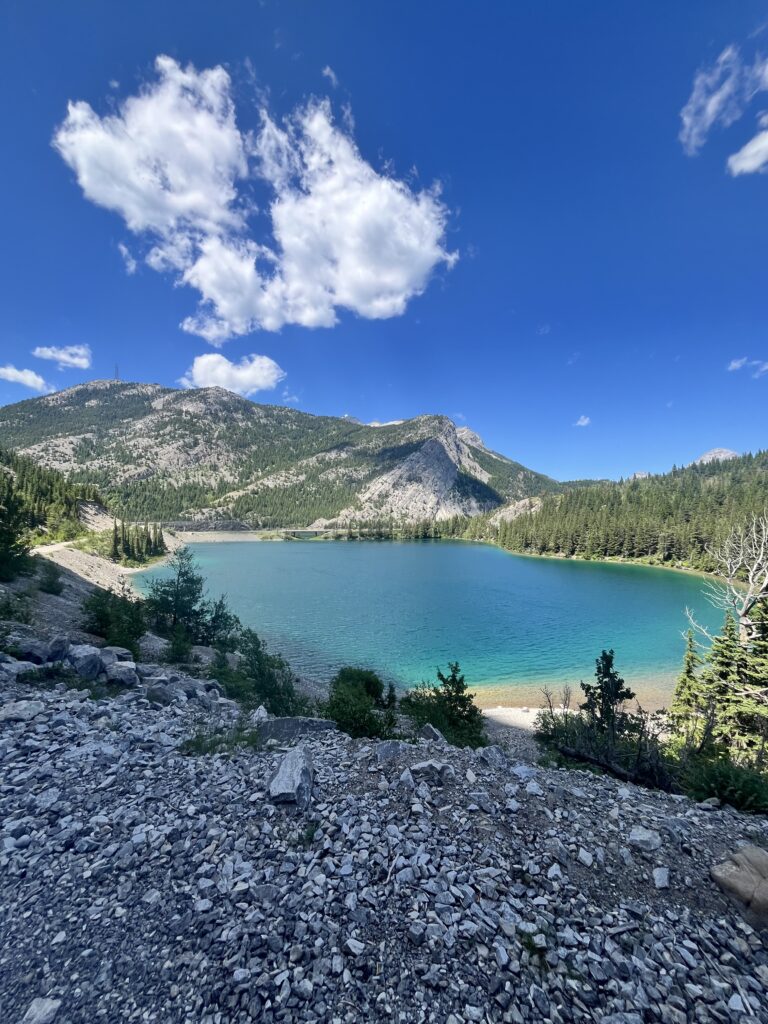Stumbling upon wolf scat is not the way many people would want to start a hike. For our twelve-person group, it was like Christmas. All of us gathered around the scat as our instructor, Kaleb, asked us questions about what animal it was from and how old it looked. We all gave unique answers, unknowingly adding to our group’s collective knowledge. In an interview we read between Robin Wall Kimmerer and Leath Tonino, Kimmerer introduces and discusses the traditional perspective and the relationship between the observer and the observed through an example of measuring and weighing fish. Through connecting the weight of fish from the current year to similar weights of years past, and the causes of past weights like food abundance and seasonality, explanations for the current weights of the fish emerge. The accumulation of observations from years past and from various perspectives allows people to draw connections between experiences and deepen their relationship with the Earth.

After our first encounter with the wolf scat, we knew how to identify it as we continued hiking. Our collective knowledge, compiled of all of our individual observations, grew throughout our nine day backpacking trip in the Bob Marshall Wilderness, known affectionately as “The Bob.” We were able to share with each other the names of plant species, animal tracks, and mammal species we had learned from the books we had brought along that expanded our own knowledge. For example, a trailmate, Norah, and I were observing a plant with purple flowers that we had seen throughout our hikes but couldn’t identify with our books. Two of our other trailmates, Jack and Coburn, had also observed the same plant and identified it as Silky Lupine. Norah and I were able to use that snippet from all four of our lived experiences observing the plant and, throughout the rest of our trip, we were able to identify all of the Silky Lupine we saw.
The following week after leaving The Bob, we had the opportunity to speak with Chief Bird (Dr. Mike Bruised Head), a member of the Blackfoot Confederacy who recently completed his Ph.D. thesis on returning Blackfoot names to the mountains of Glacier National Park. In the middle of our three-hour talk with him, we started discussing lived experiences and their importance to Indigenous Knowledge. As an example of showing us a lived experience, Chief Bird had us observe a Quaking Aspen nearby. He asked a few of us to look at the tree and say an observation out loud. One person said, “the leaves are rippling in the wind,” another said, “the bark is light gray with dark gray spots,” and another said, “it looks like it is waving.” He pointed out that every person who observed it said something different and had a different perspective when observing the aspen tree. The unique lived experiences with the aspen created the collective intelligence about the tree, providing an example of how Indigenous Knowledge works. His explanation helped me to truly understand the concept of lived experience.
Another instance of lived experience in my time on Conservation Across Boundaries (CxB) happened the day after we met with Chief Bird. We ventured into Glacier National Park at Many Glacier to complete our plant study. We hiked up the trail leading to Iceberg Lake until we found a nice spot with various blooming species. We stopped and each of us picked a plant we knew nothing about. I picked a plant with groups of pink and green buds that I had seen before but couldn’t identify. After observing, drawing, and learning about our plant, everyone presented their plants and what they learned. One of my trailmates, Emily, and I had the same plant! During our separate presentations, Emily and I shared different observations about the same plant. It was just as Chief Bird described while talking about lived experience. Different people with different perspectives make unique observations. Over time, multiple generations making observations result in a large, metaphorical puzzle of knowledge with each observation adding a piece. The puzzle pieces have no edges, allowing for knowledge to be continually added.
Vine Deloria discusses how through their observations, Native people began to notice connections between things in their environment. An example I picked up from one of our trail days is when I was observing my plant for the plant study, which I identified as Sulfur Buckwheat. I had noticed a few buckwheats growing next to a trio of Scarlett Indian Paintbrush. After listening to trailmate Caroline’s presentation on the paintbrush species, I learned that Scarlett Indian Paintbrush is hemiparasitic, meaning it gets its energy from both the sun and surrounding plants, in this case, my Sulfur Buckwheat. Without Caroline’s informative presentation on the paintbrush species, I would not have made that connection. Connections between species and how they interact is essential learning from Traditional Ecological Knowledge (T.E.K.).
Throughout my CxB experience, I’ve been strengthening my observation skills through varying lived experiences and different learning processes. After reading about and discussing T.E.K., I could apply the learning process to my daily nature observation for my journal. By focusing on the discrete characteristics of the organism I was observing, I felt closer to it and I felt as though I was deepening my relationship with the Earth. I felt confident and excited to share my findings with the group.
From wolf scat to Silky Lupine, our CxB collective knowledge puzzle is vast and ever growing. I’m excited to see how my trailmates and I will utilize it in the future.
One Reply to “Lived Experiences and a Collective Knowledge on Both Sides of the 49th Parallel by Rachel Marten”
Comments are closed.
Well written and illustrative of the collective observation process. Clearly this experience has been enlightening not only to you, but the reader as well! You have discovered to the true connection between the earth and its stewards.